Nissan's People Management Strategies: A Detailed Analysis Report
VerifiedAdded on 2023/06/15
|11
|2784
|190
Report
AI Summary
This report provides an analysis of people management practices at Nissan, a multinational Japanese automobile manufacturing company. It explores various aspects of personnel management, including leadership and management styles, training and development programs, and talent management strategies. The report discusses different leadership theories, management approaches, and their impact on Nissan's operations. It also examines the company's training and development initiatives, highlighting their benefits and challenges, and identifies gaps in their implementation. Furthermore, the report analyzes Nissan's talent management practices, focusing on attracting, selecting, and retaining employees, and emphasizes the importance of strategic human resource management in achieving organizational goals. The analysis includes recommendations for improvement and highlights Nissan's commitment to employee engagement, diversity, and continuous innovation in a competitive global environment.
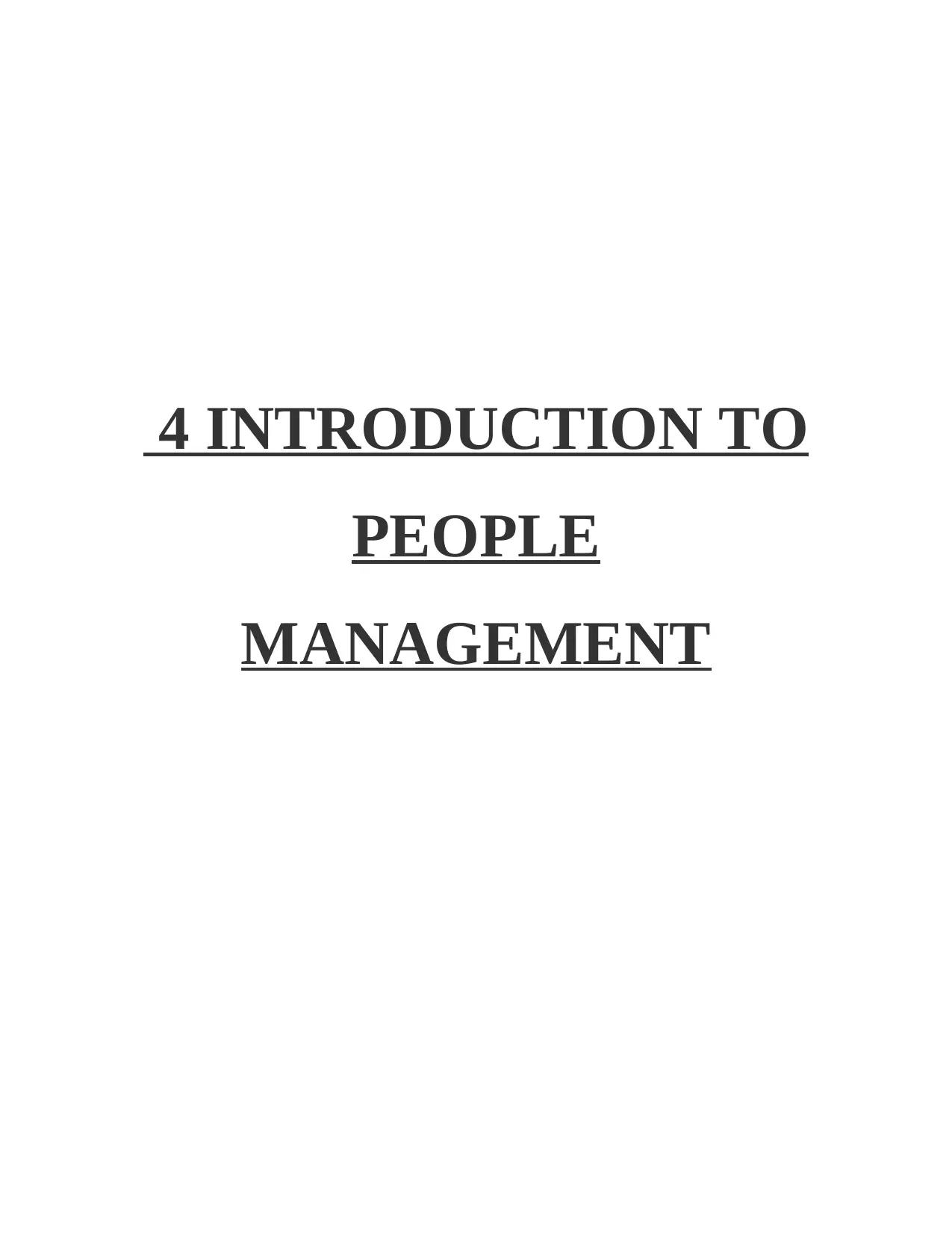
4 INTRODUCTION TO
PEOPLE
MANAGEMENT
PEOPLE
MANAGEMENT
Paraphrase This Document
Need a fresh take? Get an instant paraphrase of this document with our AI Paraphraser
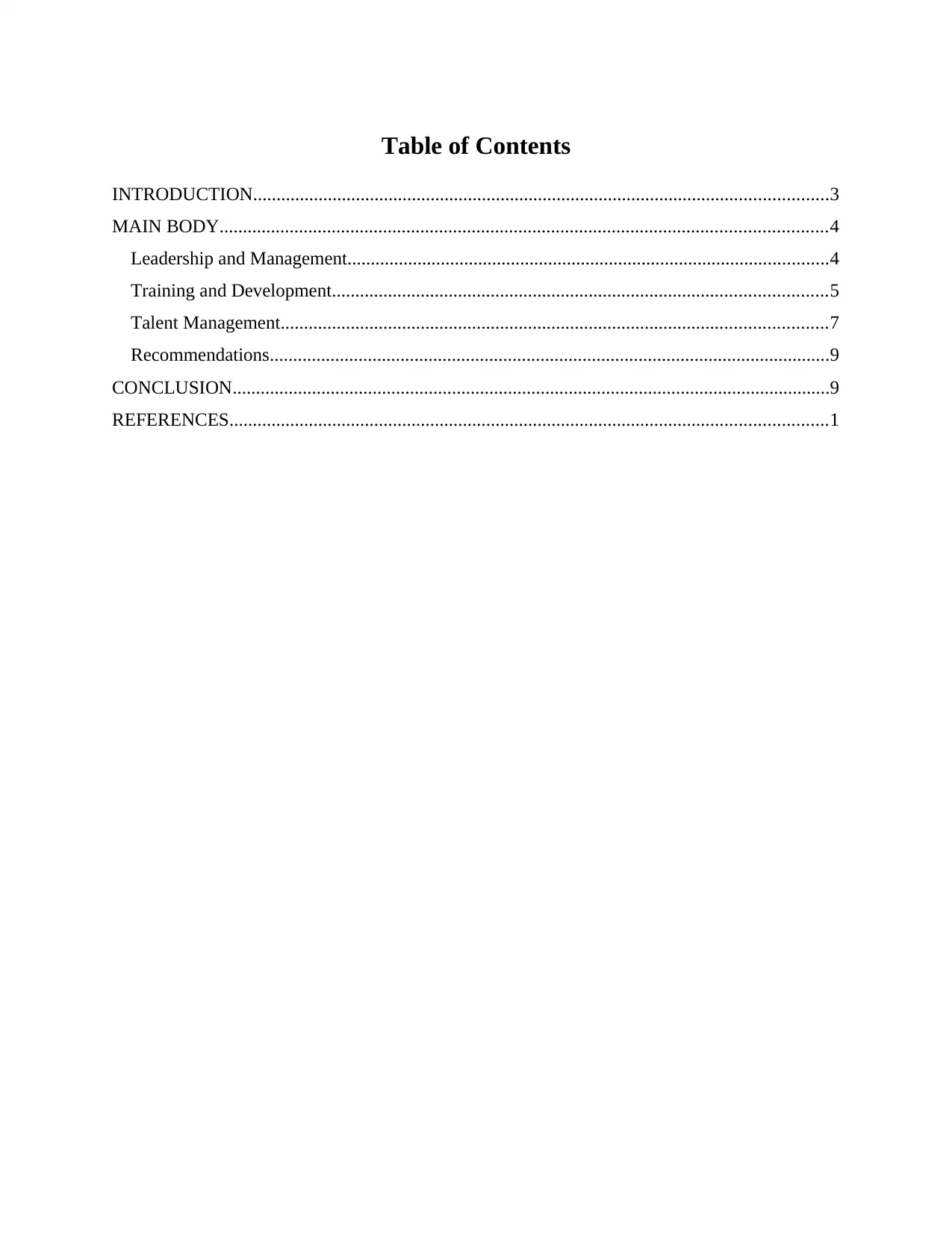
Table of Contents
INTRODUCTION...........................................................................................................................3
MAIN BODY..................................................................................................................................4
Leadership and Management.......................................................................................................4
Training and Development..........................................................................................................5
Talent Management.....................................................................................................................7
Recommendations........................................................................................................................9
CONCLUSION................................................................................................................................9
REFERENCES................................................................................................................................1
INTRODUCTION...........................................................................................................................3
MAIN BODY..................................................................................................................................4
Leadership and Management.......................................................................................................4
Training and Development..........................................................................................................5
Talent Management.....................................................................................................................7
Recommendations........................................................................................................................9
CONCLUSION................................................................................................................................9
REFERENCES................................................................................................................................1
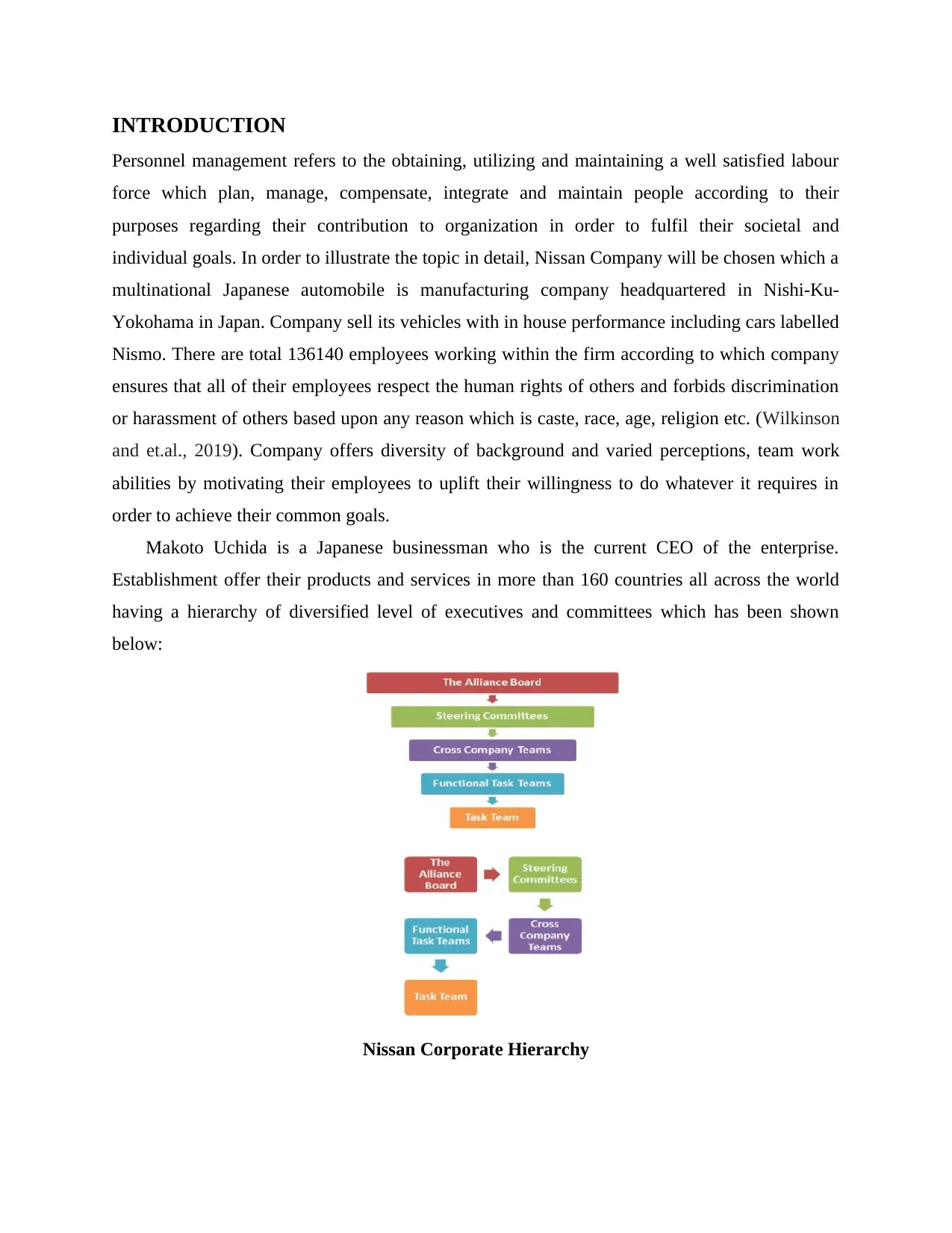
INTRODUCTION
Personnel management refers to the obtaining, utilizing and maintaining a well satisfied labour
force which plan, manage, compensate, integrate and maintain people according to their
purposes regarding their contribution to organization in order to fulfil their societal and
individual goals. In order to illustrate the topic in detail, Nissan Company will be chosen which a
multinational Japanese automobile is manufacturing company headquartered in Nishi-Ku-
Yokohama in Japan. Company sell its vehicles with in house performance including cars labelled
Nismo. There are total 136140 employees working within the firm according to which company
ensures that all of their employees respect the human rights of others and forbids discrimination
or harassment of others based upon any reason which is caste, race, age, religion etc. (Wilkinson
and et.al., 2019). Company offers diversity of background and varied perceptions, team work
abilities by motivating their employees to uplift their willingness to do whatever it requires in
order to achieve their common goals.
Makoto Uchida is a Japanese businessman who is the current CEO of the enterprise.
Establishment offer their products and services in more than 160 countries all across the world
having a hierarchy of diversified level of executives and committees which has been shown
below:
Nissan Corporate Hierarchy
Personnel management refers to the obtaining, utilizing and maintaining a well satisfied labour
force which plan, manage, compensate, integrate and maintain people according to their
purposes regarding their contribution to organization in order to fulfil their societal and
individual goals. In order to illustrate the topic in detail, Nissan Company will be chosen which a
multinational Japanese automobile is manufacturing company headquartered in Nishi-Ku-
Yokohama in Japan. Company sell its vehicles with in house performance including cars labelled
Nismo. There are total 136140 employees working within the firm according to which company
ensures that all of their employees respect the human rights of others and forbids discrimination
or harassment of others based upon any reason which is caste, race, age, religion etc. (Wilkinson
and et.al., 2019). Company offers diversity of background and varied perceptions, team work
abilities by motivating their employees to uplift their willingness to do whatever it requires in
order to achieve their common goals.
Makoto Uchida is a Japanese businessman who is the current CEO of the enterprise.
Establishment offer their products and services in more than 160 countries all across the world
having a hierarchy of diversified level of executives and committees which has been shown
below:
Nissan Corporate Hierarchy
⊘ This is a preview!⊘
Do you want full access?
Subscribe today to unlock all pages.

Trusted by 1+ million students worldwide
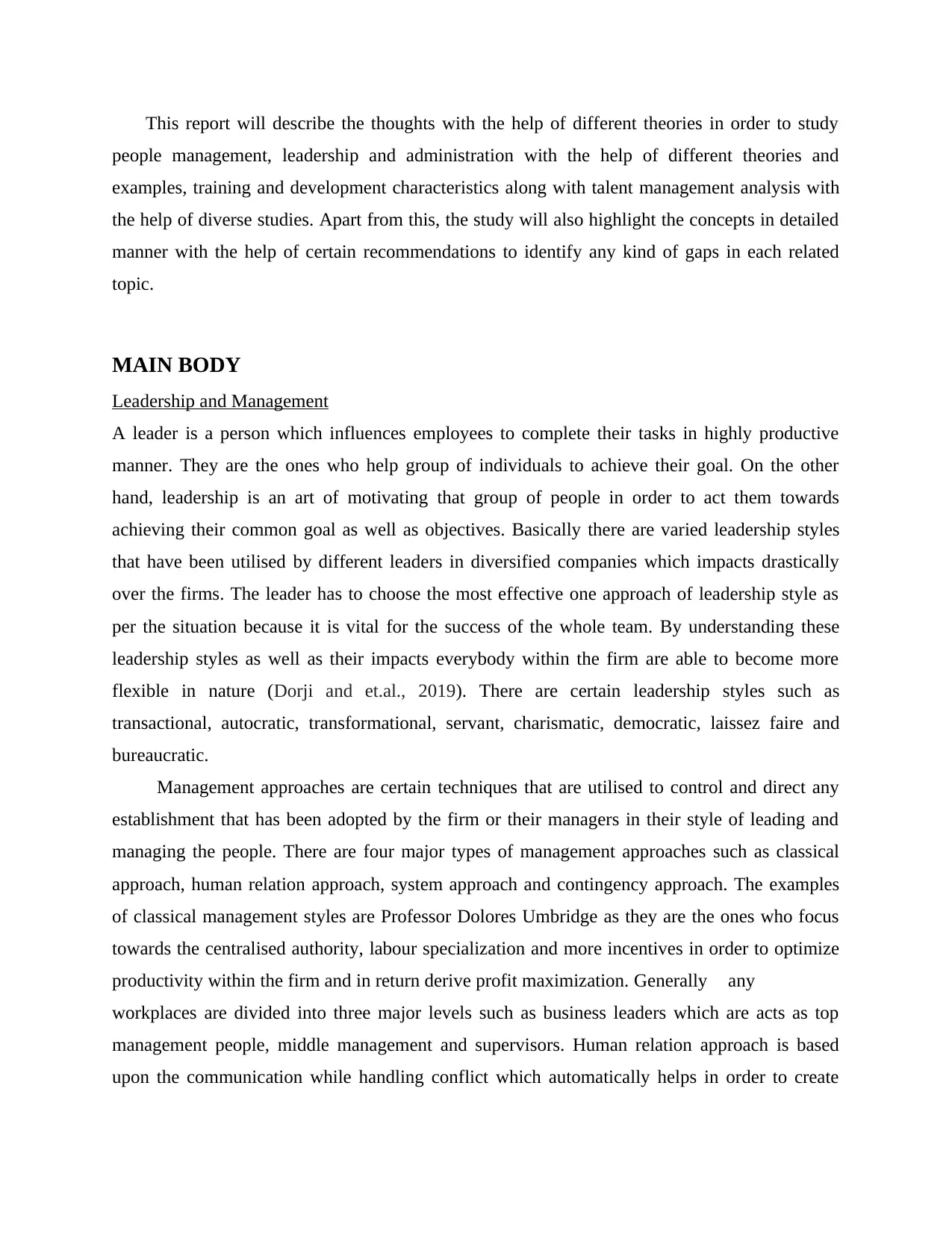
This report will describe the thoughts with the help of different theories in order to study
people management, leadership and administration with the help of different theories and
examples, training and development characteristics along with talent management analysis with
the help of diverse studies. Apart from this, the study will also highlight the concepts in detailed
manner with the help of certain recommendations to identify any kind of gaps in each related
topic.
MAIN BODY
Leadership and Management
A leader is a person which influences employees to complete their tasks in highly productive
manner. They are the ones who help group of individuals to achieve their goal. On the other
hand, leadership is an art of motivating that group of people in order to act them towards
achieving their common goal as well as objectives. Basically there are varied leadership styles
that have been utilised by different leaders in diversified companies which impacts drastically
over the firms. The leader has to choose the most effective one approach of leadership style as
per the situation because it is vital for the success of the whole team. By understanding these
leadership styles as well as their impacts everybody within the firm are able to become more
flexible in nature (Dorji and et.al., 2019). There are certain leadership styles such as
transactional, autocratic, transformational, servant, charismatic, democratic, laissez faire and
bureaucratic.
Management approaches are certain techniques that are utilised to control and direct any
establishment that has been adopted by the firm or their managers in their style of leading and
managing the people. There are four major types of management approaches such as classical
approach, human relation approach, system approach and contingency approach. The examples
of classical management styles are Professor Dolores Umbridge as they are the ones who focus
towards the centralised authority, labour specialization and more incentives in order to optimize
productivity within the firm and in return derive profit maximization. Generally any
workplaces are divided into three major levels such as business leaders which are acts as top
management people, middle management and supervisors. Human relation approach is based
upon the communication while handling conflict which automatically helps in order to create
people management, leadership and administration with the help of different theories and
examples, training and development characteristics along with talent management analysis with
the help of diverse studies. Apart from this, the study will also highlight the concepts in detailed
manner with the help of certain recommendations to identify any kind of gaps in each related
topic.
MAIN BODY
Leadership and Management
A leader is a person which influences employees to complete their tasks in highly productive
manner. They are the ones who help group of individuals to achieve their goal. On the other
hand, leadership is an art of motivating that group of people in order to act them towards
achieving their common goal as well as objectives. Basically there are varied leadership styles
that have been utilised by different leaders in diversified companies which impacts drastically
over the firms. The leader has to choose the most effective one approach of leadership style as
per the situation because it is vital for the success of the whole team. By understanding these
leadership styles as well as their impacts everybody within the firm are able to become more
flexible in nature (Dorji and et.al., 2019). There are certain leadership styles such as
transactional, autocratic, transformational, servant, charismatic, democratic, laissez faire and
bureaucratic.
Management approaches are certain techniques that are utilised to control and direct any
establishment that has been adopted by the firm or their managers in their style of leading and
managing the people. There are four major types of management approaches such as classical
approach, human relation approach, system approach and contingency approach. The examples
of classical management styles are Professor Dolores Umbridge as they are the ones who focus
towards the centralised authority, labour specialization and more incentives in order to optimize
productivity within the firm and in return derive profit maximization. Generally any
workplaces are divided into three major levels such as business leaders which are acts as top
management people, middle management and supervisors. Human relation approach is based
upon the communication while handling conflict which automatically helps in order to create
Paraphrase This Document
Need a fresh take? Get an instant paraphrase of this document with our AI Paraphraser
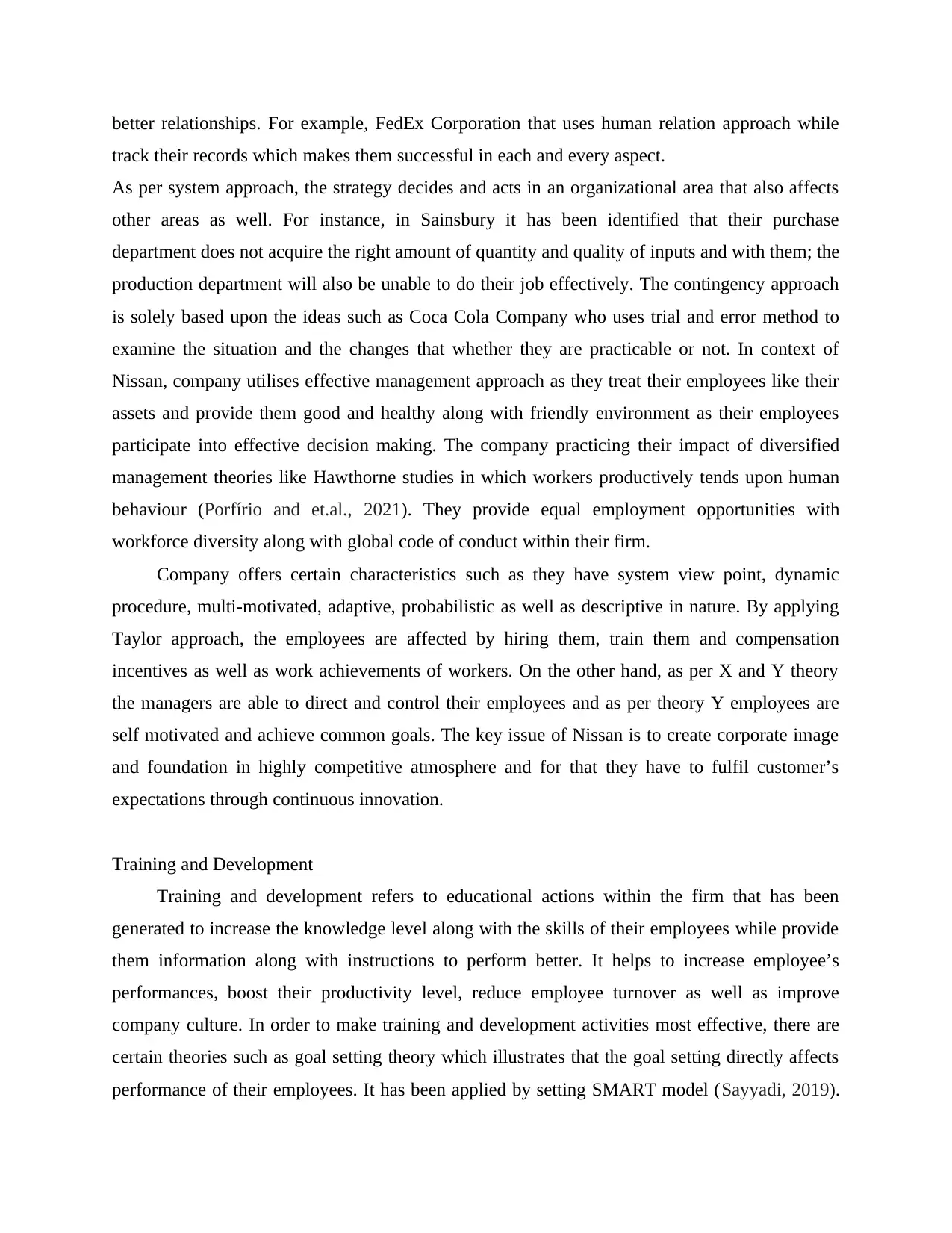
better relationships. For example, FedEx Corporation that uses human relation approach while
track their records which makes them successful in each and every aspect.
As per system approach, the strategy decides and acts in an organizational area that also affects
other areas as well. For instance, in Sainsbury it has been identified that their purchase
department does not acquire the right amount of quantity and quality of inputs and with them; the
production department will also be unable to do their job effectively. The contingency approach
is solely based upon the ideas such as Coca Cola Company who uses trial and error method to
examine the situation and the changes that whether they are practicable or not. In context of
Nissan, company utilises effective management approach as they treat their employees like their
assets and provide them good and healthy along with friendly environment as their employees
participate into effective decision making. The company practicing their impact of diversified
management theories like Hawthorne studies in which workers productively tends upon human
behaviour (Porfírio and et.al., 2021). They provide equal employment opportunities with
workforce diversity along with global code of conduct within their firm.
Company offers certain characteristics such as they have system view point, dynamic
procedure, multi-motivated, adaptive, probabilistic as well as descriptive in nature. By applying
Taylor approach, the employees are affected by hiring them, train them and compensation
incentives as well as work achievements of workers. On the other hand, as per X and Y theory
the managers are able to direct and control their employees and as per theory Y employees are
self motivated and achieve common goals. The key issue of Nissan is to create corporate image
and foundation in highly competitive atmosphere and for that they have to fulfil customer’s
expectations through continuous innovation.
Training and Development
Training and development refers to educational actions within the firm that has been
generated to increase the knowledge level along with the skills of their employees while provide
them information along with instructions to perform better. It helps to increase employee’s
performances, boost their productivity level, reduce employee turnover as well as improve
company culture. In order to make training and development activities most effective, there are
certain theories such as goal setting theory which illustrates that the goal setting directly affects
performance of their employees. It has been applied by setting SMART model (Sayyadi, 2019).
track their records which makes them successful in each and every aspect.
As per system approach, the strategy decides and acts in an organizational area that also affects
other areas as well. For instance, in Sainsbury it has been identified that their purchase
department does not acquire the right amount of quantity and quality of inputs and with them; the
production department will also be unable to do their job effectively. The contingency approach
is solely based upon the ideas such as Coca Cola Company who uses trial and error method to
examine the situation and the changes that whether they are practicable or not. In context of
Nissan, company utilises effective management approach as they treat their employees like their
assets and provide them good and healthy along with friendly environment as their employees
participate into effective decision making. The company practicing their impact of diversified
management theories like Hawthorne studies in which workers productively tends upon human
behaviour (Porfírio and et.al., 2021). They provide equal employment opportunities with
workforce diversity along with global code of conduct within their firm.
Company offers certain characteristics such as they have system view point, dynamic
procedure, multi-motivated, adaptive, probabilistic as well as descriptive in nature. By applying
Taylor approach, the employees are affected by hiring them, train them and compensation
incentives as well as work achievements of workers. On the other hand, as per X and Y theory
the managers are able to direct and control their employees and as per theory Y employees are
self motivated and achieve common goals. The key issue of Nissan is to create corporate image
and foundation in highly competitive atmosphere and for that they have to fulfil customer’s
expectations through continuous innovation.
Training and Development
Training and development refers to educational actions within the firm that has been
generated to increase the knowledge level along with the skills of their employees while provide
them information along with instructions to perform better. It helps to increase employee’s
performances, boost their productivity level, reduce employee turnover as well as improve
company culture. In order to make training and development activities most effective, there are
certain theories such as goal setting theory which illustrates that the goal setting directly affects
performance of their employees. It has been applied by setting SMART model (Sayyadi, 2019).
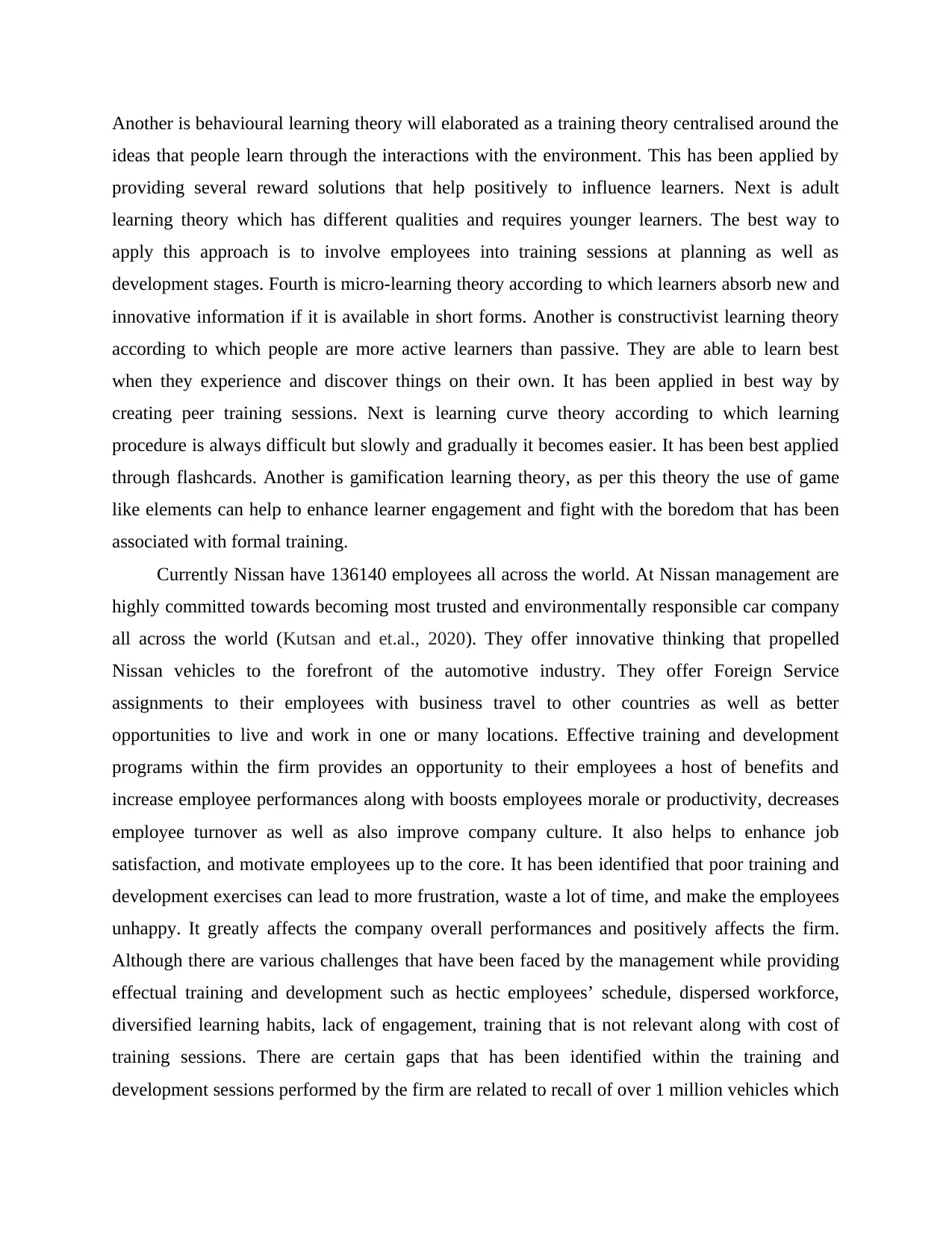
Another is behavioural learning theory will elaborated as a training theory centralised around the
ideas that people learn through the interactions with the environment. This has been applied by
providing several reward solutions that help positively to influence learners. Next is adult
learning theory which has different qualities and requires younger learners. The best way to
apply this approach is to involve employees into training sessions at planning as well as
development stages. Fourth is micro-learning theory according to which learners absorb new and
innovative information if it is available in short forms. Another is constructivist learning theory
according to which people are more active learners than passive. They are able to learn best
when they experience and discover things on their own. It has been applied in best way by
creating peer training sessions. Next is learning curve theory according to which learning
procedure is always difficult but slowly and gradually it becomes easier. It has been best applied
through flashcards. Another is gamification learning theory, as per this theory the use of game
like elements can help to enhance learner engagement and fight with the boredom that has been
associated with formal training.
Currently Nissan have 136140 employees all across the world. At Nissan management are
highly committed towards becoming most trusted and environmentally responsible car company
all across the world (Kutsan and et.al., 2020). They offer innovative thinking that propelled
Nissan vehicles to the forefront of the automotive industry. They offer Foreign Service
assignments to their employees with business travel to other countries as well as better
opportunities to live and work in one or many locations. Effective training and development
programs within the firm provides an opportunity to their employees a host of benefits and
increase employee performances along with boosts employees morale or productivity, decreases
employee turnover as well as also improve company culture. It also helps to enhance job
satisfaction, and motivate employees up to the core. It has been identified that poor training and
development exercises can lead to more frustration, waste a lot of time, and make the employees
unhappy. It greatly affects the company overall performances and positively affects the firm.
Although there are various challenges that have been faced by the management while providing
effectual training and development such as hectic employees’ schedule, dispersed workforce,
diversified learning habits, lack of engagement, training that is not relevant along with cost of
training sessions. There are certain gaps that has been identified within the training and
development sessions performed by the firm are related to recall of over 1 million vehicles which
ideas that people learn through the interactions with the environment. This has been applied by
providing several reward solutions that help positively to influence learners. Next is adult
learning theory which has different qualities and requires younger learners. The best way to
apply this approach is to involve employees into training sessions at planning as well as
development stages. Fourth is micro-learning theory according to which learners absorb new and
innovative information if it is available in short forms. Another is constructivist learning theory
according to which people are more active learners than passive. They are able to learn best
when they experience and discover things on their own. It has been applied in best way by
creating peer training sessions. Next is learning curve theory according to which learning
procedure is always difficult but slowly and gradually it becomes easier. It has been best applied
through flashcards. Another is gamification learning theory, as per this theory the use of game
like elements can help to enhance learner engagement and fight with the boredom that has been
associated with formal training.
Currently Nissan have 136140 employees all across the world. At Nissan management are
highly committed towards becoming most trusted and environmentally responsible car company
all across the world (Kutsan and et.al., 2020). They offer innovative thinking that propelled
Nissan vehicles to the forefront of the automotive industry. They offer Foreign Service
assignments to their employees with business travel to other countries as well as better
opportunities to live and work in one or many locations. Effective training and development
programs within the firm provides an opportunity to their employees a host of benefits and
increase employee performances along with boosts employees morale or productivity, decreases
employee turnover as well as also improve company culture. It also helps to enhance job
satisfaction, and motivate employees up to the core. It has been identified that poor training and
development exercises can lead to more frustration, waste a lot of time, and make the employees
unhappy. It greatly affects the company overall performances and positively affects the firm.
Although there are various challenges that have been faced by the management while providing
effectual training and development such as hectic employees’ schedule, dispersed workforce,
diversified learning habits, lack of engagement, training that is not relevant along with cost of
training sessions. There are certain gaps that has been identified within the training and
development sessions performed by the firm are related to recall of over 1 million vehicles which
⊘ This is a preview!⊘
Do you want full access?
Subscribe today to unlock all pages.

Trusted by 1+ million students worldwide
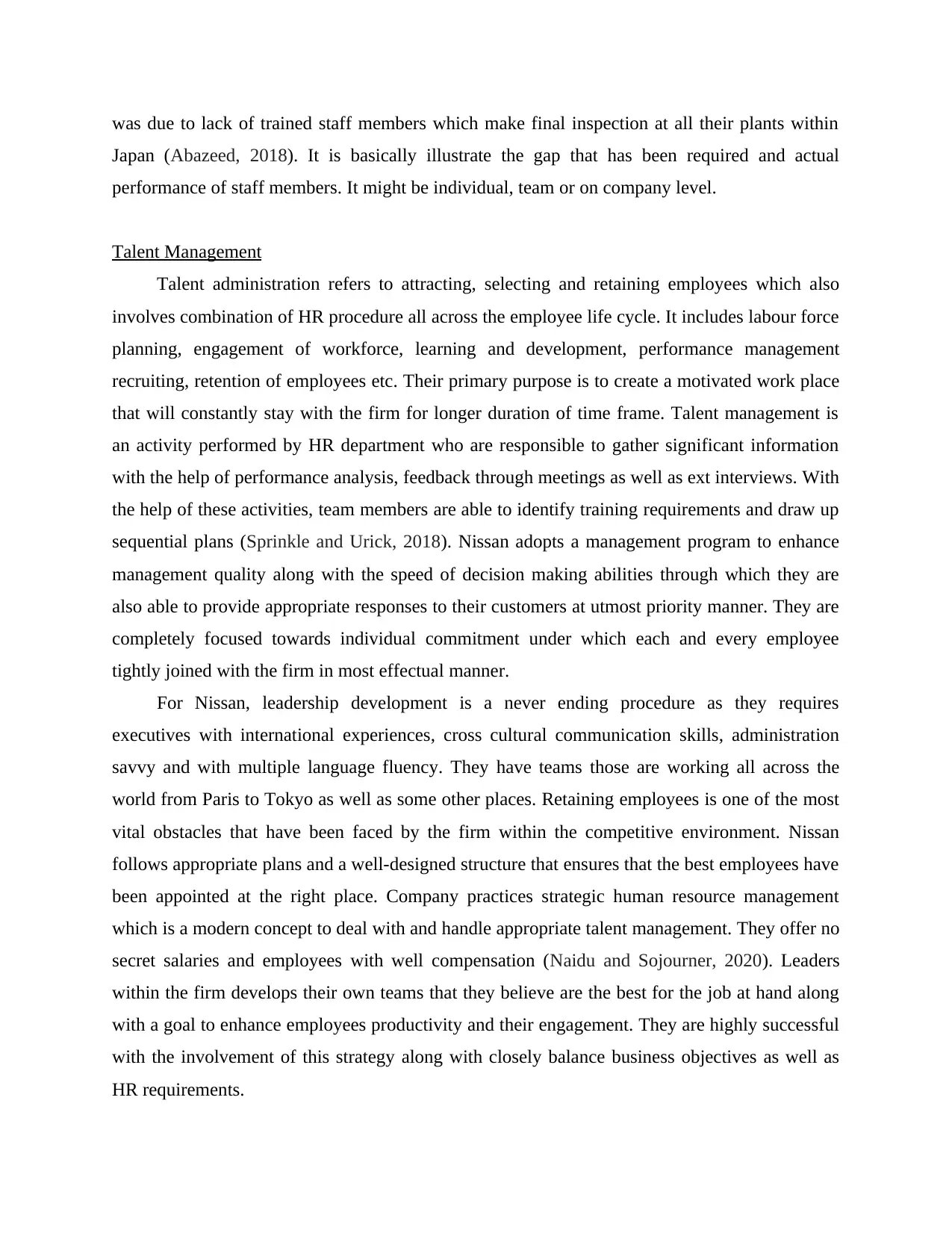
was due to lack of trained staff members which make final inspection at all their plants within
Japan (Abazeed, 2018). It is basically illustrate the gap that has been required and actual
performance of staff members. It might be individual, team or on company level.
Talent Management
Talent administration refers to attracting, selecting and retaining employees which also
involves combination of HR procedure all across the employee life cycle. It includes labour force
planning, engagement of workforce, learning and development, performance management
recruiting, retention of employees etc. Their primary purpose is to create a motivated work place
that will constantly stay with the firm for longer duration of time frame. Talent management is
an activity performed by HR department who are responsible to gather significant information
with the help of performance analysis, feedback through meetings as well as ext interviews. With
the help of these activities, team members are able to identify training requirements and draw up
sequential plans (Sprinkle and Urick, 2018). Nissan adopts a management program to enhance
management quality along with the speed of decision making abilities through which they are
also able to provide appropriate responses to their customers at utmost priority manner. They are
completely focused towards individual commitment under which each and every employee
tightly joined with the firm in most effectual manner.
For Nissan, leadership development is a never ending procedure as they requires
executives with international experiences, cross cultural communication skills, administration
savvy and with multiple language fluency. They have teams those are working all across the
world from Paris to Tokyo as well as some other places. Retaining employees is one of the most
vital obstacles that have been faced by the firm within the competitive environment. Nissan
follows appropriate plans and a well-designed structure that ensures that the best employees have
been appointed at the right place. Company practices strategic human resource management
which is a modern concept to deal with and handle appropriate talent management. They offer no
secret salaries and employees with well compensation (Naidu and Sojourner, 2020). Leaders
within the firm develops their own teams that they believe are the best for the job at hand along
with a goal to enhance employees productivity and their engagement. They are highly successful
with the involvement of this strategy along with closely balance business objectives as well as
HR requirements.
Japan (Abazeed, 2018). It is basically illustrate the gap that has been required and actual
performance of staff members. It might be individual, team or on company level.
Talent Management
Talent administration refers to attracting, selecting and retaining employees which also
involves combination of HR procedure all across the employee life cycle. It includes labour force
planning, engagement of workforce, learning and development, performance management
recruiting, retention of employees etc. Their primary purpose is to create a motivated work place
that will constantly stay with the firm for longer duration of time frame. Talent management is
an activity performed by HR department who are responsible to gather significant information
with the help of performance analysis, feedback through meetings as well as ext interviews. With
the help of these activities, team members are able to identify training requirements and draw up
sequential plans (Sprinkle and Urick, 2018). Nissan adopts a management program to enhance
management quality along with the speed of decision making abilities through which they are
also able to provide appropriate responses to their customers at utmost priority manner. They are
completely focused towards individual commitment under which each and every employee
tightly joined with the firm in most effectual manner.
For Nissan, leadership development is a never ending procedure as they requires
executives with international experiences, cross cultural communication skills, administration
savvy and with multiple language fluency. They have teams those are working all across the
world from Paris to Tokyo as well as some other places. Retaining employees is one of the most
vital obstacles that have been faced by the firm within the competitive environment. Nissan
follows appropriate plans and a well-designed structure that ensures that the best employees have
been appointed at the right place. Company practices strategic human resource management
which is a modern concept to deal with and handle appropriate talent management. They offer no
secret salaries and employees with well compensation (Naidu and Sojourner, 2020). Leaders
within the firm develops their own teams that they believe are the best for the job at hand along
with a goal to enhance employees productivity and their engagement. They are highly successful
with the involvement of this strategy along with closely balance business objectives as well as
HR requirements.
Paraphrase This Document
Need a fresh take? Get an instant paraphrase of this document with our AI Paraphraser

Company follows best way to encourage their employees by adopting cross functional,
cross-cultural and frugal that also includes motivation and challenge development. Diversity acts
as significant strategy at Nissan Company. Nissan lead their employees with proper vision; make
everybody understand their things, set clear targets, recognise great work, giving them
welcoming work environment, offer impressive benefits as well as encourage them for doing
team work. With the help of this, employees feel engaged, motivated and skilled along with
allow them to work towards common direction that helps to achieve as well as company
common goals (Kamenez and et.al., 2019). Their impact over the firm is drastic as it provides
essential information and strategies for further improvement and changes along with recognize
talented people who are potentially becoming future leaders of the establishment. With the
proper involvement of management, the firm attract and retain high quality employees by
developing their staff as well as continuously motivating them to enhance their performances.
Nissan administration effectively creates a motivated work place that will stay with the firm for
long term.
cross-cultural and frugal that also includes motivation and challenge development. Diversity acts
as significant strategy at Nissan Company. Nissan lead their employees with proper vision; make
everybody understand their things, set clear targets, recognise great work, giving them
welcoming work environment, offer impressive benefits as well as encourage them for doing
team work. With the help of this, employees feel engaged, motivated and skilled along with
allow them to work towards common direction that helps to achieve as well as company
common goals (Kamenez and et.al., 2019). Their impact over the firm is drastic as it provides
essential information and strategies for further improvement and changes along with recognize
talented people who are potentially becoming future leaders of the establishment. With the
proper involvement of management, the firm attract and retain high quality employees by
developing their staff as well as continuously motivating them to enhance their performances.
Nissan administration effectively creates a motivated work place that will stay with the firm for
long term.
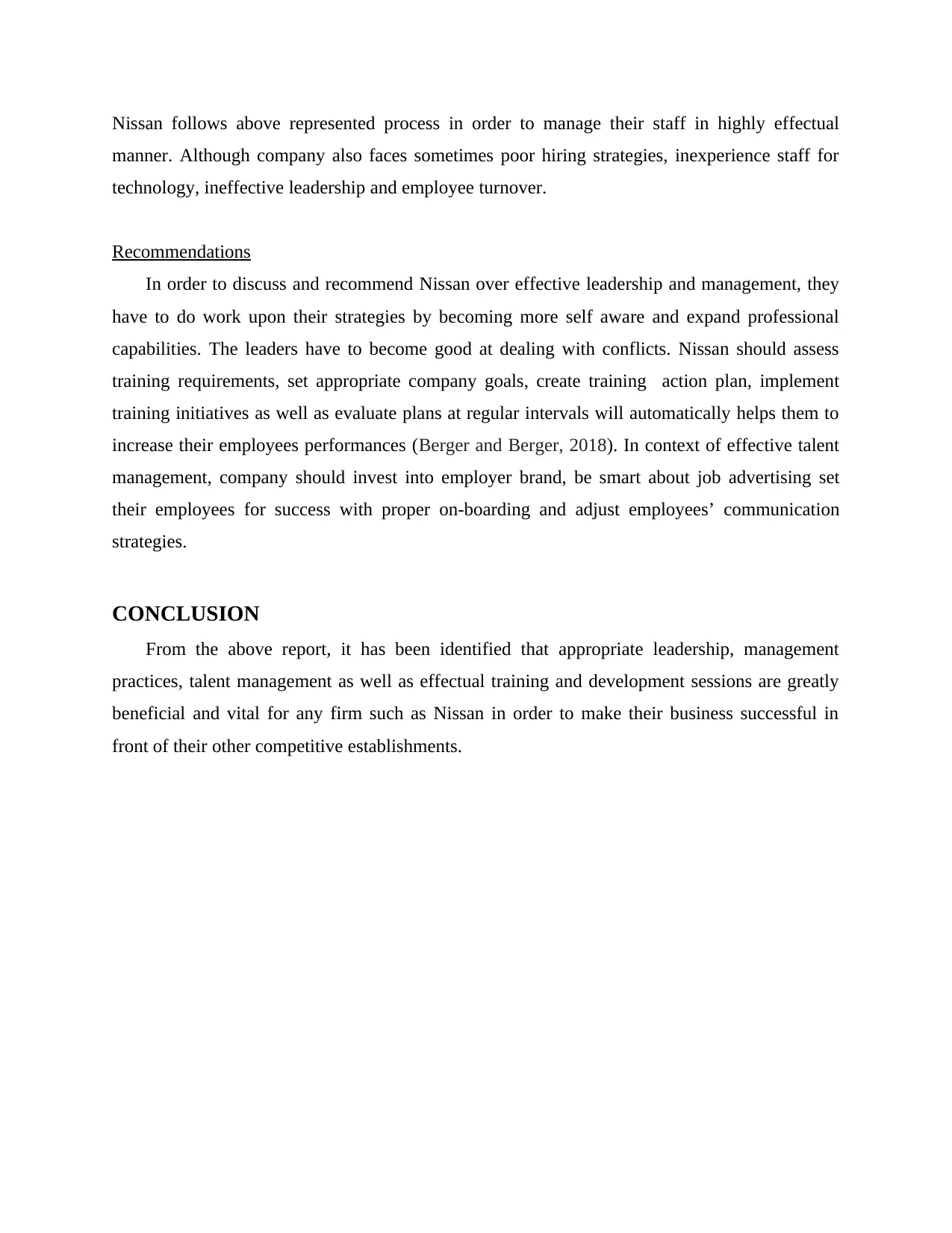
Nissan follows above represented process in order to manage their staff in highly effectual
manner. Although company also faces sometimes poor hiring strategies, inexperience staff for
technology, ineffective leadership and employee turnover.
Recommendations
In order to discuss and recommend Nissan over effective leadership and management, they
have to do work upon their strategies by becoming more self aware and expand professional
capabilities. The leaders have to become good at dealing with conflicts. Nissan should assess
training requirements, set appropriate company goals, create training action plan, implement
training initiatives as well as evaluate plans at regular intervals will automatically helps them to
increase their employees performances (Berger and Berger, 2018). In context of effective talent
management, company should invest into employer brand, be smart about job advertising set
their employees for success with proper on-boarding and adjust employees’ communication
strategies.
CONCLUSION
From the above report, it has been identified that appropriate leadership, management
practices, talent management as well as effectual training and development sessions are greatly
beneficial and vital for any firm such as Nissan in order to make their business successful in
front of their other competitive establishments.
manner. Although company also faces sometimes poor hiring strategies, inexperience staff for
technology, ineffective leadership and employee turnover.
Recommendations
In order to discuss and recommend Nissan over effective leadership and management, they
have to do work upon their strategies by becoming more self aware and expand professional
capabilities. The leaders have to become good at dealing with conflicts. Nissan should assess
training requirements, set appropriate company goals, create training action plan, implement
training initiatives as well as evaluate plans at regular intervals will automatically helps them to
increase their employees performances (Berger and Berger, 2018). In context of effective talent
management, company should invest into employer brand, be smart about job advertising set
their employees for success with proper on-boarding and adjust employees’ communication
strategies.
CONCLUSION
From the above report, it has been identified that appropriate leadership, management
practices, talent management as well as effectual training and development sessions are greatly
beneficial and vital for any firm such as Nissan in order to make their business successful in
front of their other competitive establishments.
⊘ This is a preview!⊘
Do you want full access?
Subscribe today to unlock all pages.

Trusted by 1+ million students worldwide

REFERENCES
Books and journal
Abazeed, R.A.M., 2018. The impact of talent management on organizational commitment of the
employees of telecommunication companies in Jordan: the mediating role of employee
work engagement. International Journal of Academic Research in Accounting, Finance
and Management Sciences, 8(4), pp.153-162.
Berger, L.A. and Berger, D.R. eds., 2018. The talent management handbook: Making culture a
competitive advantage by acquiring, identifying, developing, and promoting the best
people. New York: McGraw-Hill Education.
Dorji, K., and et.al., 2019. Leadership and management competencies required for Bhutanese
primary health care managers in reforming the district health system. Journal of
healthcare leadership, 11, p.13.
Kamenez, N.V., and et.al., 2019. Development of instructing techniques in professional
training. International Journal of Mechanical Engineering and Technology, 10(02),
pp.899-907.
Kutsan, Y., and et.al., 2020. Development of a virtual scientific and educational center for
personnel advanced training in the energy sector of Ukraine. In Systems, Decision and
Control in Energy I (pp. 69-84). Springer, Cham.
Naidu, S. and Sojourner, A., 2020. Employer power and employee skills: Understanding
workforce training programs in the context of labor market power. Roosevelt Institute,
December.
Nawangsari, L.C. and Sutawidjaya, A.H., 2019. Talent management in mediating competencies
and motivation to improve employee’s engagement.
Porfírio, J.A., and et.al., 2021. Leadership characteristics and digital transformation. Journal of
Business Research, 124, pp.610-619.
Sayyadi, M., 2019. How effective leadership of knowledge management impacts organizational
performance. Business Information Review, 36(1), pp.30-38.
Sprinkle, T.A. and Urick, M.J., 2018. Three generational issues in organizational learning:
Knowledge management, perspectives on training and “low-stakes” development. The
Learning Organization.
1
Books and journal
Abazeed, R.A.M., 2018. The impact of talent management on organizational commitment of the
employees of telecommunication companies in Jordan: the mediating role of employee
work engagement. International Journal of Academic Research in Accounting, Finance
and Management Sciences, 8(4), pp.153-162.
Berger, L.A. and Berger, D.R. eds., 2018. The talent management handbook: Making culture a
competitive advantage by acquiring, identifying, developing, and promoting the best
people. New York: McGraw-Hill Education.
Dorji, K., and et.al., 2019. Leadership and management competencies required for Bhutanese
primary health care managers in reforming the district health system. Journal of
healthcare leadership, 11, p.13.
Kamenez, N.V., and et.al., 2019. Development of instructing techniques in professional
training. International Journal of Mechanical Engineering and Technology, 10(02),
pp.899-907.
Kutsan, Y., and et.al., 2020. Development of a virtual scientific and educational center for
personnel advanced training in the energy sector of Ukraine. In Systems, Decision and
Control in Energy I (pp. 69-84). Springer, Cham.
Naidu, S. and Sojourner, A., 2020. Employer power and employee skills: Understanding
workforce training programs in the context of labor market power. Roosevelt Institute,
December.
Nawangsari, L.C. and Sutawidjaya, A.H., 2019. Talent management in mediating competencies
and motivation to improve employee’s engagement.
Porfírio, J.A., and et.al., 2021. Leadership characteristics and digital transformation. Journal of
Business Research, 124, pp.610-619.
Sayyadi, M., 2019. How effective leadership of knowledge management impacts organizational
performance. Business Information Review, 36(1), pp.30-38.
Sprinkle, T.A. and Urick, M.J., 2018. Three generational issues in organizational learning:
Knowledge management, perspectives on training and “low-stakes” development. The
Learning Organization.
1
Paraphrase This Document
Need a fresh take? Get an instant paraphrase of this document with our AI Paraphraser
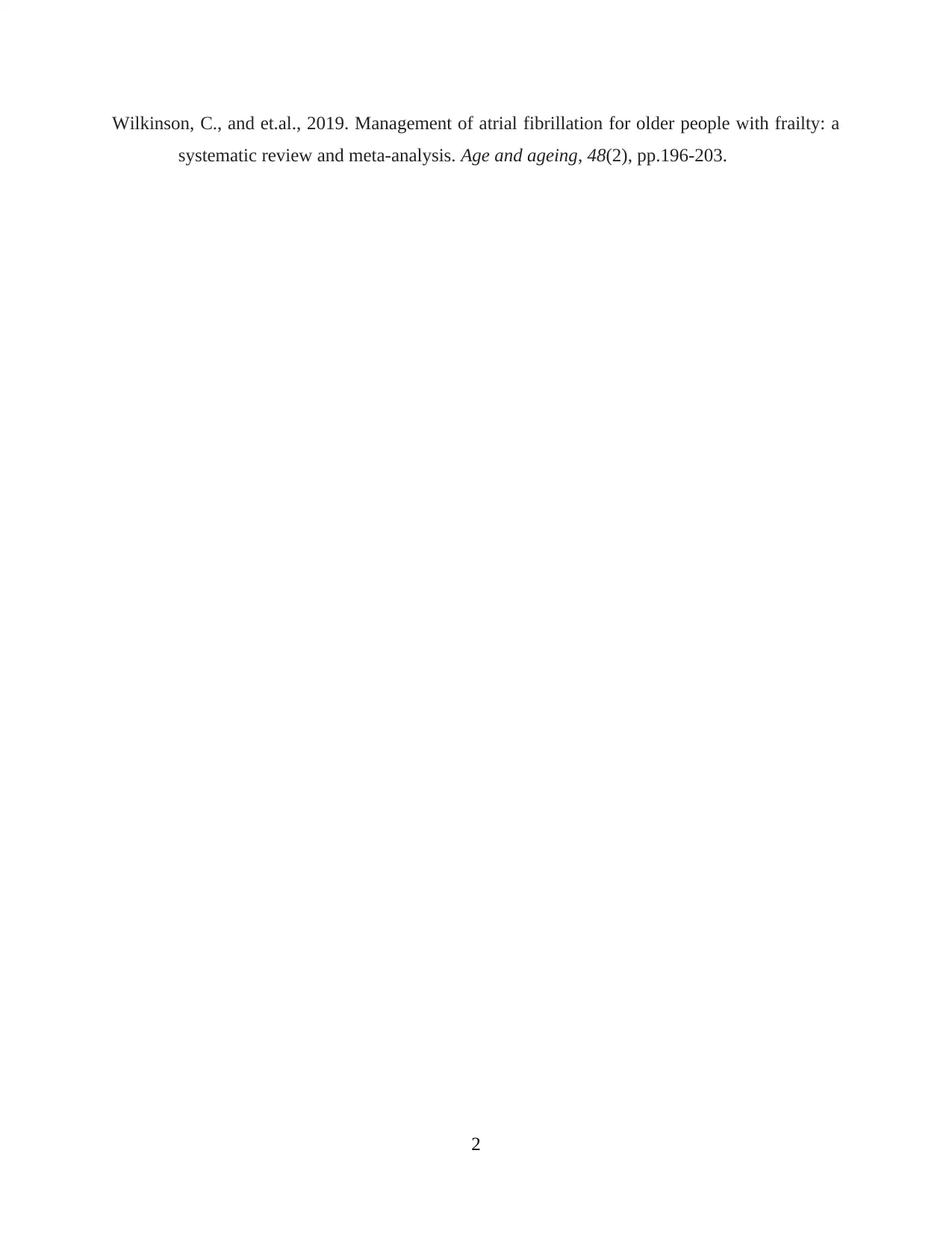
Wilkinson, C., and et.al., 2019. Management of atrial fibrillation for older people with frailty: a
systematic review and meta-analysis. Age and ageing, 48(2), pp.196-203.
2
systematic review and meta-analysis. Age and ageing, 48(2), pp.196-203.
2
1 out of 11
Related Documents
Your All-in-One AI-Powered Toolkit for Academic Success.
+13062052269
info@desklib.com
Available 24*7 on WhatsApp / Email
![[object Object]](/_next/static/media/star-bottom.7253800d.svg)
Unlock your academic potential
Copyright © 2020–2025 A2Z Services. All Rights Reserved. Developed and managed by ZUCOL.




